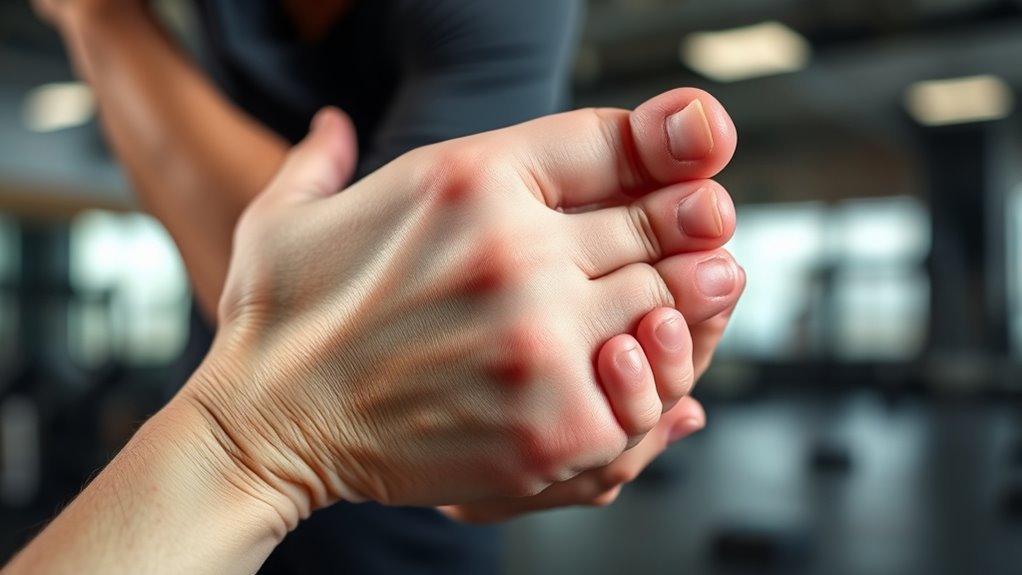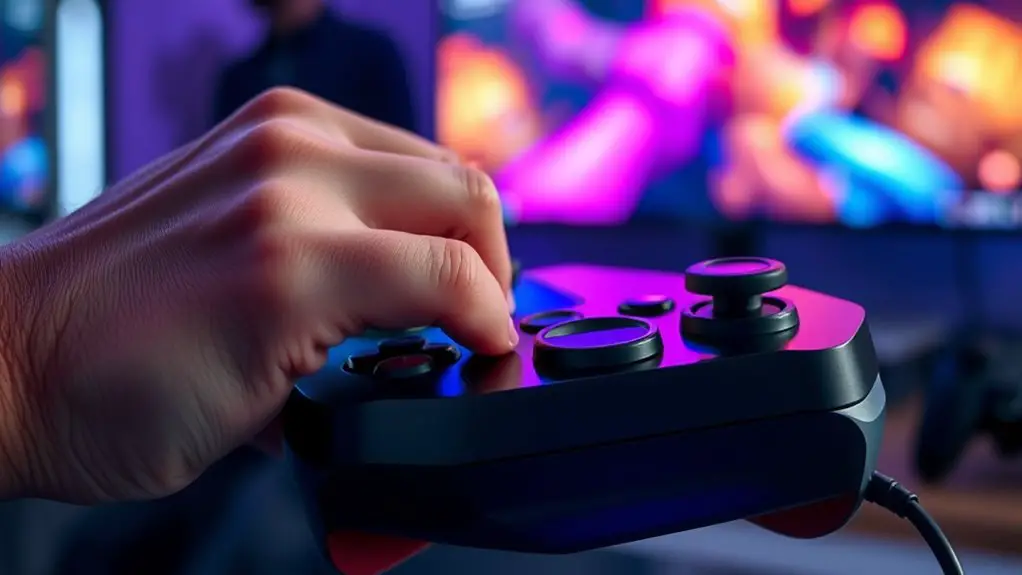Yes, athlete’s foot can spread to your hands. This typically happens through direct contact, such as scratching your infected feet and then touching your hands. Fungal infections thrive in warm, moist environments, making it easy for them to transfer. If you’re not careful with hygiene, you might increase the risk of spreading the infection. Keeping your feet clean and dry is essential. For tips on prevention and treatment, continue exploring more about this issue.
Understanding Athlete’s Foot and Its Causes
Although athlete’s foot is commonly associated with the feet, it can actually spread to other areas, like your hands. This condition arises from fungal infections that thrive in warm, moist environments. When you neglect your skin health or come into contact with contaminated surfaces, you’re at risk. The fungi can easily latch onto your skin, causing irritation and discomfort. Understanding the causes is essential for maintaining your freedom from these pesky infections. To protect yourself, keep your feet and hands clean and dry, and avoid sharing personal items. By staying vigilant, you can enjoy the freedom of healthy skin and a life free from the nuisance of athlete’s foot. Remember, prevention is your best defense against these unwelcome invaders.
How Athlete’s Foot Can Spread to Other Body Parts
When you think about athlete’s foot, you probably picture it affecting just your feet, but it can easily spread to other parts of your body, including your hands. Fungal transmission occurs through direct skin contact, so if you scratch or touch your infected feet, you risk transferring the fungus to your hands. This can happen when you’re walking barefoot in shared spaces like locker rooms or pools, where the fungus thrives. Additionally, if you don’t wash your hands after touching your feet, you’re creating a pathway for the infection to spread. To keep your freedom intact, practice good hygiene and avoid touching your feet without washing up afterward. Being mindful can help you stay fungal-free and comfortable.
Symptoms of Athlete’s Foot on Hands
If you’ve accidentally transferred the fungus from your feet to your hands, you might start noticing some telltale symptoms. Recognizing these common symptoms can help you tackle a potential hand infection early on, keeping your freedom intact. Here’s what to look for:
- Redness or swelling around the affected area
- Itching or burning sensations
- Dry, flaky skin that may peel
- Blisters or sores that can become crusty
These signs can be bothersome, but knowing what to watch for allows you to take action quickly. Don’t let athlete’s foot ruin your day! Keep your hands clean and dry, and seek treatment if you notice these symptoms. Your hands deserve the same care as your feet!
Risk Factors for Spreading Athlete’s Foot
Several key risk factors can contribute to the spread of athlete’s foot from your feet to your hands. First, if you frequently touch your feet, especially if they’re infected, you’re increasing the chances of transferring those fungal infections. Second, damp environments, like communal showers or swimming pools, can harbor the fungi that cause athlete’s foot, making it easy to spread. Third, wearing closed shoes without airflow can create a warm, moist environment that encourages fungal growth. Finally, if you have a weakened immune system or other skin conditions, you’re at a higher risk for infections. Staying aware of these factors can help you maintain your freedom from athlete’s foot and its unwelcome spread.
Effective Prevention Strategies
To keep athlete’s foot from spreading to your hands, maintaining good hygiene is essential. Make sure to wash your feet regularly and dry them thoroughly, especially between the toes. Also, avoid sharing towels or personal items to reduce the risk of transmission.
Maintain Good Hygiene
Since maintaining good hygiene is essential in preventing the spread of athlete’s foot, you should adopt a few simple practices. These habits will help you keep your feet and hands healthy, allowing you to enjoy life without worries.
- Wash your hands regularly, especially after touching your feet or shoes.
- Practice good foot care by keeping your feet clean and dry.
- Use your own towel and avoid sharing with others to minimize risk.
- Change socks daily, opting for breathable materials that wick moisture away.
Avoid Sharing Towels
While it might seem harmless, sharing towels can greatly increase the risk of spreading athlete’s foot and other fungal infections. When you engage in towel sharing, you’re not just risking your own health but potentially passing on those pesky fungi to others. To maintain high-quality personal hygiene, it’s best to stick to your own towel. This simple step can make a huge difference in preventing infections. Plus, having your own towel gives you the freedom to dry off without worry. Remember, athlete’s foot thrives in warm, damp environments, and sharing towels can create the perfect breeding ground for these fungi. So, keep your towel to yourself and enjoy peace of mind while staying healthy!
Treatment Options for Athlete’s Foot on Hands
When dealing with athlete’s foot on your hands, topical antifungal creams can be your first line of defense. Alongside medication, practicing proper hygiene is essential to prevent further spread. Let’s explore these treatment options to help you find relief.
Topical Antifungal Creams
If you notice athlete’s foot spreading to your hands, topical antifungal creams can be an effective solution. These creams provide a convenient topical application that targets the infection directly. When choosing the right cream, consider the following factors for maximum antifungal effectiveness:
- Active Ingredients: Look for creams with clotrimazole or terbinafine.
- Application Frequency: Some may require daily use, while others are more flexible.
- Skin Type: Choose a formulation that suits your skin sensitivity.
- Duration of Treatment: Follow the recommended course for best results.
Proper Hygiene Practices
Maintaining proper hygiene is essential in preventing athlete’s foot from spreading to your hands and elsewhere. Regular hand washing is your first line of defense. Make sure to wash your hands thoroughly, especially after touching your feet or shoes. Nail care is equally significant; keep your nails trimmed and clean to avoid trapping fungi.
Here’s a quick reference table for effective hygiene practices:
| Practice | Description |
|---|---|
| Hand Washing | Wash with soap and water for at least 20 seconds. |
| Nail Care | Trim nails regularly and keep them dry. |
| Drying Hands | Use a clean towel or air dry to prevent moisture. |
| Shoe Hygiene | Rotate shoes and use antifungal spray. |
| Avoid Sharing | Don’t share towels, shoes, or socks. |
Frequently Asked Questions
Can Athlete’s Foot Be Mistaken for Other Hand Conditions?
Yes, athlete’s foot can be mistaken for other hand conditions. When you look at symptoms comparison, you might notice redness, itching, or peeling skin, which could resemble eczema or psoriasis. These similarities can create diagnosis challenges for healthcare professionals. It’s essential to get a proper evaluation if you’re experiencing these symptoms, as treating the wrong condition could lead to prolonged discomfort. Stay aware, and don’t hesitate to seek medical advice.
Is Athlete’s Foot Contagious Through Shared Towels?
Absolutely, athlete’s foot can spread through shared towels. Imagine you’re at a friend’s place after a workout, and you grab a towel that wasn’t properly cleaned. Fungal transmission can happen easily that way. To keep your feet—and hands—healthy, prioritize towel hygiene. Always use your own towel to dry off after workouts, and avoid sharing to reduce the risk. Remember, a little caution goes a long way in keeping you free and healthy!
How Long Can Athlete’s Foot Fungus Survive on Surfaces?
Athlete’s foot fungus can survive on surfaces for several weeks to months, depending on the environment. If you’re not careful, surface contamination can lead to infections. It thrives in warm, damp areas, so be wary of shared spaces like locker rooms. To keep yourself free from the fungus, regularly clean surfaces and avoid walking barefoot in communal areas. Staying vigilant helps you enjoy activities without the worry of unwanted infections!
Can I Exercise With Athlete’s Foot on My Hands?
You can exercise with athlete’s foot on your hands, but it’s essential to take some exercise precautions. Make sure to wash your hands thoroughly before and after your workout to maintain proper hand hygiene. Avoid touching shared equipment directly with your hands, and consider using gloves if possible. Staying mindful of these practices can help minimize the risk of spreading the infection while still enjoying your freedom to work out.
Will Athlete’s Foot Reoccur After Treatment?
Yes, athlete’s foot can recur after treatment. Recurrence factors include poor hygiene, damp environments, and sharing personal items. To prevent it from coming back, keep your feet dry, wear moisture-wicking socks, and use antifungal powders. Also, avoid walking barefoot in public areas like pools or gyms. By following these prevention strategies, you can enjoy your freedom from athlete’s foot and keep your feet healthy and comfortable.



